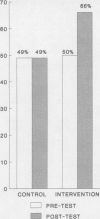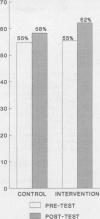Abstract
OBJECTIVES. Outdoor workers are at high risk of developing skin cancer. Primary prevention in this group can potentially reduce the incidence of skin cancer, and also potentiates the spontaneous remission of existing solar keratoses. A randomized controlled trial was conducted to evaluate a solar protection intervention targeting outdoor workers. METHODS. Outdoor workers were randomly allocated to an intervention (n = 65) or control group (n = 77). The intervention group received individual skin screening by a dermatologist and participated in an education session. Pre- and posttest outcome measures included solar protection behavior (assessed using a validated diary), knowledge, and attitudes. RESULTS. There was a significant increase (16%) in the percentage of outdoor workers who were using a high level of solar protection at posttest compared to pretest in the intervention group, but there was no change in the control group. Although both groups improved in their knowledge score, the intervention group showed a significantly greater improvement at posttest. No changes in attitudes were detected. CONCLUSIONS. The findings suggest that changes in solar protection are achievable with outdoor workers.
Full text
PDF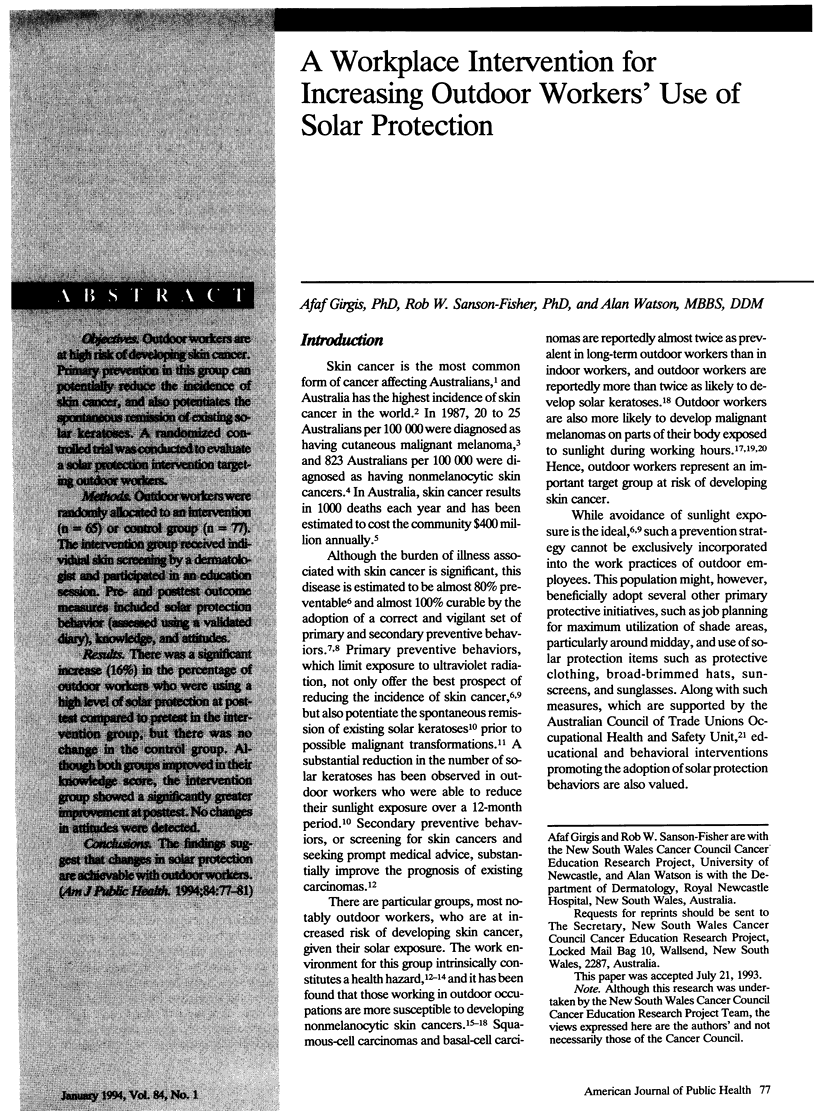
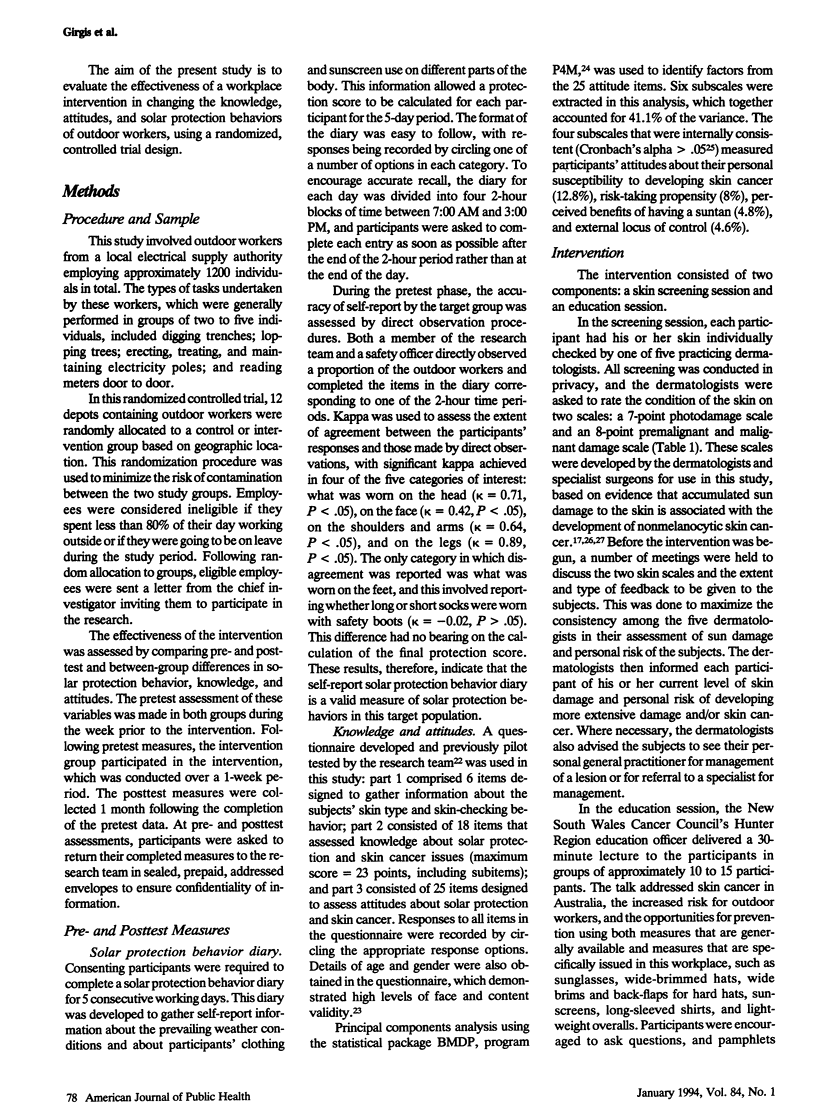
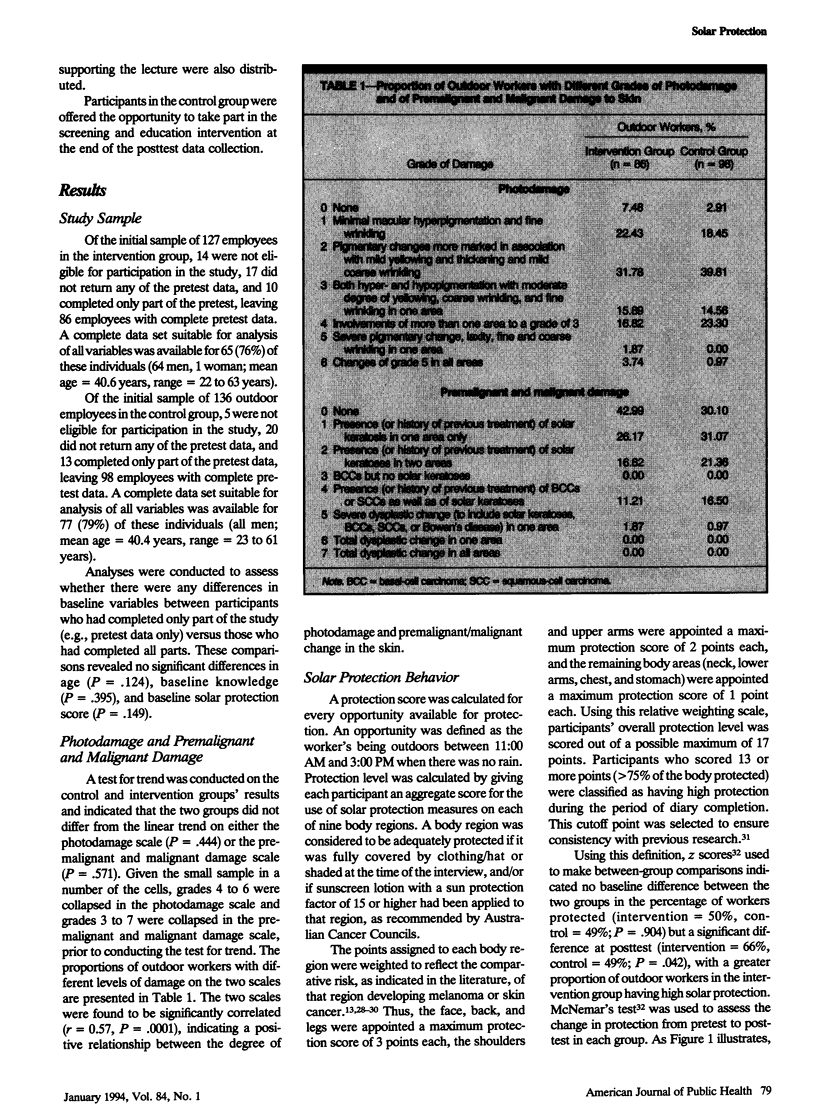


Images in this article
Selected References
These references are in PubMed. This may not be the complete list of references from this article.
- Armstrong B. K. The epidemiology and prevention of cancer in Australia. Aust N Z J Surg. 1988 Mar;58(3):179–187. doi: 10.1111/j.1445-2197.1988.tb01035.x. [DOI] [PubMed] [Google Scholar]
- Bendl B. J., Graham J. H. New concepts on the origin of squamous cell carcinomas of the skin: solar (senile) keratosis with squamous cell carcinoma--a clinicopathologic and histochemical study. Proc Natl Cancer Conf. 1970;6:471–488. [PubMed] [Google Scholar]
- Beral V., Robinson N. The relationship of malignant melanoma, basal and squamous skin cancers to indoor and outdoor work. Br J Cancer. 1981 Dec;44(6):886–891. doi: 10.1038/bjc.1981.288. [DOI] [PMC free article] [PubMed] [Google Scholar]
- Breslow A. Thickness, cross-sectional areas and depth of invasion in the prognosis of cutaneous melanoma. Ann Surg. 1970 Nov;172(5):902–908. doi: 10.1097/00000658-197011000-00017. [DOI] [PMC free article] [PubMed] [Google Scholar]
- Conrad P. Health and fitness at work: a participants' perspective. Soc Sci Med. 1988;26(5):545–550. doi: 10.1016/0277-9536(88)90387-5. [DOI] [PubMed] [Google Scholar]
- Evans J. F., Miller O. F. Malignant melanoma and its precursors. The growing need for early identification. Postgrad Med. 1986 Feb 1;79(2):215–222. doi: 10.1080/00325481.1986.11699280. [DOI] [PubMed] [Google Scholar]
- Fitzpatrick T. B., Sober A. J. Sunlight and skin cancer. N Engl J Med. 1985 Sep 26;313(13):818–820. doi: 10.1056/NEJM198509263131310. [DOI] [PubMed] [Google Scholar]
- Foot G., Girgis A., Boyle C. A., Sanson-Fisher R. W. Solar protection behaviours: a study of beachgoers. Aust J Public Health. 1993 Sep;17(3):209–214. [PubMed] [Google Scholar]
- Giles G. G., Marks R., Foley P. Incidence of non-melanocytic skin cancer treated in Australia. Br Med J (Clin Res Ed) 1988 Jan 2;296(6614):13–17. doi: 10.1136/bmj.296.6614.13. [DOI] [PMC free article] [PubMed] [Google Scholar]
- Girgis A., Sanson-Fisher R. W., Tripodi D. A., Golding T. Evaluation of interventions to improve solar protection in primary schools. Health Educ Q. 1993 Summer;20(2):275–287. doi: 10.1177/109019819302000217. [DOI] [PubMed] [Google Scholar]
- Green A., Beardmore G., Hart V., Leslie D., Marks R., Staines D. Skin cancer in a Queensland population. J Am Acad Dermatol. 1988 Dec;19(6):1045–1052. doi: 10.1016/s0190-9622(88)70270-4. [DOI] [PubMed] [Google Scholar]
- Hollander R. B., Lengermann J. J. Corporate characteristics and worksite health promotion programs: survey findings from Fortune 500 companies. Soc Sci Med. 1988;26(5):491–501. doi: 10.1016/0277-9536(88)90382-6. [DOI] [PubMed] [Google Scholar]
- Holman C. D., Armstrong B. K., Evans P. R., Lumsden G. J., Dallimore K. J., Meehan C. J., Beagley J., Gibson I. M. Relationship of solar keratosis and history of skin cancer to objective measures of actinic skin damage. Br J Dermatol. 1984 Feb;110(2):129–138. doi: 10.1111/j.1365-2133.1984.tb07458.x. [DOI] [PubMed] [Google Scholar]
- Johnson B. E. Solar radiation and skin cancer. Br J Cancer. 1973 Jul;28(1):91–91. doi: 10.1038/bjc.1973.118. [DOI] [PMC free article] [PubMed] [Google Scholar]
- Marks R., Foley P., Goodman G., Hage B. H., Selwood T. S. Spontaneous remission of solar keratoses: the case for conservative management. Br J Dermatol. 1986 Dec;115(6):649–655. doi: 10.1111/j.1365-2133.1986.tb06644.x. [DOI] [PubMed] [Google Scholar]
- Marks R., Ponsford M. W., Selwood T. S., Goodman G., Mason G. Non-melanotic skin cancer and solar keratoses in Victoria. Med J Aust. 1983 Dec 10;2(12):619–622. doi: 10.5694/j.1326-5377.1983.tb122724.x. [DOI] [PubMed] [Google Scholar]
- Marks R., Selwood T. S. Solar keratoses. The association with erythemal ultraviolet radiation in Australia. Cancer. 1985 Nov 1;56(9):2332–2336. doi: 10.1002/1097-0142(19851101)56:9<2232::aid-cncr2820560934>3.0.co;2-g. [DOI] [PubMed] [Google Scholar]
- McCarthy W. H., Shaw H. M. Skin cancer in Australia. Med J Aust. 1989 May 1;150(9):469–470. doi: 10.5694/j.1326-5377.1989.tb136585.x. [DOI] [PubMed] [Google Scholar]
- Roman P. M., Blum T. C. Formal intervention in employee health: comparisons of the nature and structure of employee assistance programs and health promotion programs. Soc Sci Med. 1988;26(5):503–514. doi: 10.1016/0277-9536(88)90383-8. [DOI] [PubMed] [Google Scholar]
- Sober A. J. Solar exposure in the etiology of cutaneous melanoma. Photodermatol. 1987 Feb;4(1):23–31. [PubMed] [Google Scholar]
- Stachnik T. J., Stoffelmayr B. E. Is there a future for smoking cessation programs? J Community Health. 1981 Fall;7(1):47–56. doi: 10.1007/BF01323080. [DOI] [PubMed] [Google Scholar]
- Stern R. S., Weinstein M. C., Baker S. G. Risk reduction for nonmelanoma skin cancer with childhood sunscreen use. Arch Dermatol. 1986 May;122(5):537–545. [PubMed] [Google Scholar]
- Vågero D., Ringbäck G., Kiviranta H. Melanoma and other tumors of the skin among office, other indoor and outdoor workers in Sweden 1961-1979. Br J Cancer. 1986 Apr;53(4):507–512. doi: 10.1038/bjc.1986.80. [DOI] [PMC free article] [PubMed] [Google Scholar]
- Watson A. Sunscreen effectiveness: theoretical and practical considerations. Australas J Dermatol. 1983 Apr;24(1):17–22. doi: 10.1111/j.1440-0960.1983.tb00242.x. [DOI] [PubMed] [Google Scholar]
- Zavela K. J., Davis L. G., Cottrell R. R., Smith W. E. Do only the healthy intend to participate in worksite health promotion? Health Educ Q. 1988 Fall;15(3):259–267. doi: 10.1177/109019818801500302. [DOI] [PubMed] [Google Scholar]



